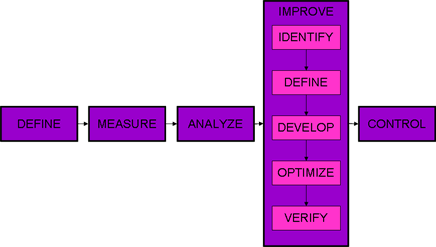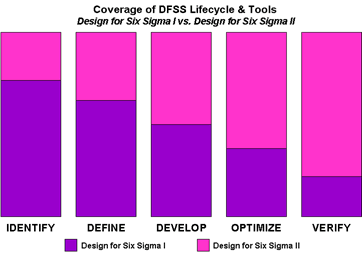|
DOQS SIX SIGMA SERIES
Design for Six Sigma I
This course covers the design of specific solutions that achieve 6-sigma
process capability. Designing such process capability into a solution
requires an additional set of rigor and control beyond that accomplished
on most improvement projects. DFSS covers an integrated deployment of
business requirements, functional specifications, system design, and operational
implementation that allows critical design variables to be prioritized
and optimized across each layer. One view of DFSS is that it applies DMAIC
improvement to each level of the DFSS design, optimizing the cross-level
integration and interaction. Another view is that DFSS builds in self-correcting
mechanisms by emphasizing the gap between 3-sigma control limits and 6-sigma
specification limits. (4 days, $20,000,
Required prerequisite: Six Sigma Improvement
II, Recommended prerequisite: Introduction
to Requirements Engineering or Introduction
to Quality Engineering)
Process Coverage
Design for Six Sigma is not independent of the Six Sigma Improvement
model. Opportunities for new systems, or components of systems, arise
out of the DMAIC analysis process. Implementing a system using DFSS always
takes place in the context of the DMAIC-driven improvement and always
results in an implementation that is sustained by DMAIC-derived controls,
even if the DMAIC efforts are not explicitly associated with the DFSS
effort.

Lifecycle Coverage (DFSS)
Design for Six Sigma is based on an Identify-Define-Develop-Optimize-Verify
(IDDOV) lifecycle that emphasizes identifying and designing innovative
solutions against opportunities defined during traditional DMAIC initiatives.
The DMAIC lifecycle is viewed as the driver of scope and direction.

This course covers the entire IDDOV lifecycle, but emphasizes
activities toward the front end. Tool coverage is complete enough to build
a comprehensive and integrated design, but optimization and tuning of
that design is deferred until the Design for Six Sigma II course.
-
Identify the Opportunity - Driven by the measurement
and analysis phases of DMAIC, identification activities clarify particular
product or service opportunities that can be implemented to help solve
the problems being addressed by the DMAIC activity. Whether the need
is for a comprehensive systems solution, or a collection of independent
components that collectively will solve the problem, their identification
initiates the DFSS process.
-
Define the Requirements - Comprehensive requirements
engineering is a central theme of DFSS, with integrated models developed
for Customer Needs, Business Processes, Functional Systems, Systems
Designs, and Operational Support. Emphasis is placed on defining exhaustive
requirements with a high level of control and quantification. Customer
needs define requirements priorities, leading to a requirements management
model that might implement as a single solution, or a series of releases
planned over time.
-
Develop the Concept - As requirements progress toward
implementation details, various conceptual solutions are continuously
being identified and evaluated as stronger and stronger alternatives
emerge and drive subsequent engineering activities. Evaluation might
include various forms of experimentation, simulation, or prototyping
to better understand design parameters and performance relationships.
-
Optimize the Design - Once a best conceptual solution
has solidified in response to the prioritized and allocated requirements,
the design parameters and performance relationships are driven toward
optimal values using further experimentation and analysis. Critical
design variables and functional dimensions are designed toward maximizing
satisfaction and performance.
-
Verify Conformance - Once a systematic and rigorous
design has been optimized, it must be verified and validated against
the original requirements, as well as the critical-to-quality control
values that have been established at each level of the overall design.
The quantification of requirements must be assured, followed by the
review and approval of stakeholders to be impacted by the design.
Other common DFSS lifecycle models are also discussed, including Define-Measure-Analyze-Design-Verify
(DMADV) and Define-Model-Optimize-Verify-Control (DMOVC). These lifecycles
aim to accomplish goals similar to those of the IDDOV lifecycle. They
are typically seen in environments trying to implement DFSS on a standalone
basis, independent of DMAIC. We believe that DFSS works best if it attempts
to integrate the findings and tools of DMAIC into a comprehensive design.
DMAIC measurement and analysis activities always lay the groundwork for
effective design, and so we integrate them to illustrate and maximize
that effect.
Tool Coverage
-
Voice of the Customer (VoC) - While Voice of the
Customer was introduced in DMAIC as a general process for gathering
and validating requirements, when integrated into DFSS it is tailored
to the various layers that constitute a whole system design. Overall
customer needs become differentiated from their preferences for functional
capability or design performance targets.
-
House of Quality (HoQ) - The set of matrices that
constitute the House of Quality allow for the definition, analysis,
prioritization, and quantification of intersecting requirements. The
rows define what's needed, and the columns define how the need will
be met. The context in which the HoQ is built (e.g. analysis, design,
operations) determines the types and depth of entries along these
two dimensions.
-
Quality Function Deployment (QFD) - QFD is the primary
integration tool of DFSS because it forms the backbone that ties all
other Six Sigma tool results together. The QFD is built as a series
of related HoQ matrices, where the columns of one matrix become the
rows of the next. Beyond integration of the multiple levels of design
detail, the QFD provides for prioritization and quantification of
requirements and design parameters at all levels of the design model,
and assures traceability from implementation back to the original
voice of the customer.
-
Pugh Concept Selection - Each time a design team
transitions from one level of the QFD to the next, the columns of
the previous level become the rows of the next. Where does the subsequent
set of columns come from? Pugh supports the identification of multiple
alternatives and supports the negotiation of a best hybrid alternative.
The chosen alternative is considered least vulnerable to disruption,
and becomes the columns of the next layer of QFD.
-
Design Failure Mode and Effect Analysis (DFMEA) -
Just as the Process FMEA improved the design and specification of
processes in DMAIC, the Design FMEA is used to continuously improve
the quality of the design that is emerging through the QFD.
- Design for "X" - Any number of factors
might be relevant to the definition of quality during a systems initiative.
DFSS involves being able to incorporate a variety of factors "X"
into a design, working toward a solution set that optimizes their interaction
against customer needs and requirements. Common "X" factors
in this course include Testability, Reliability, Maintainability. Other
"X" factors are covered in Design for Six Sigma II course.
|




